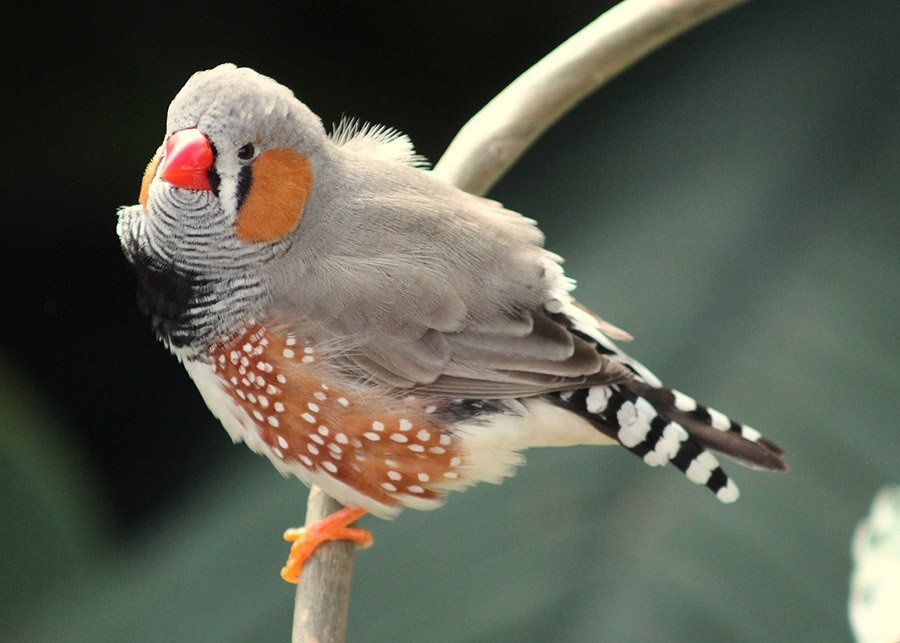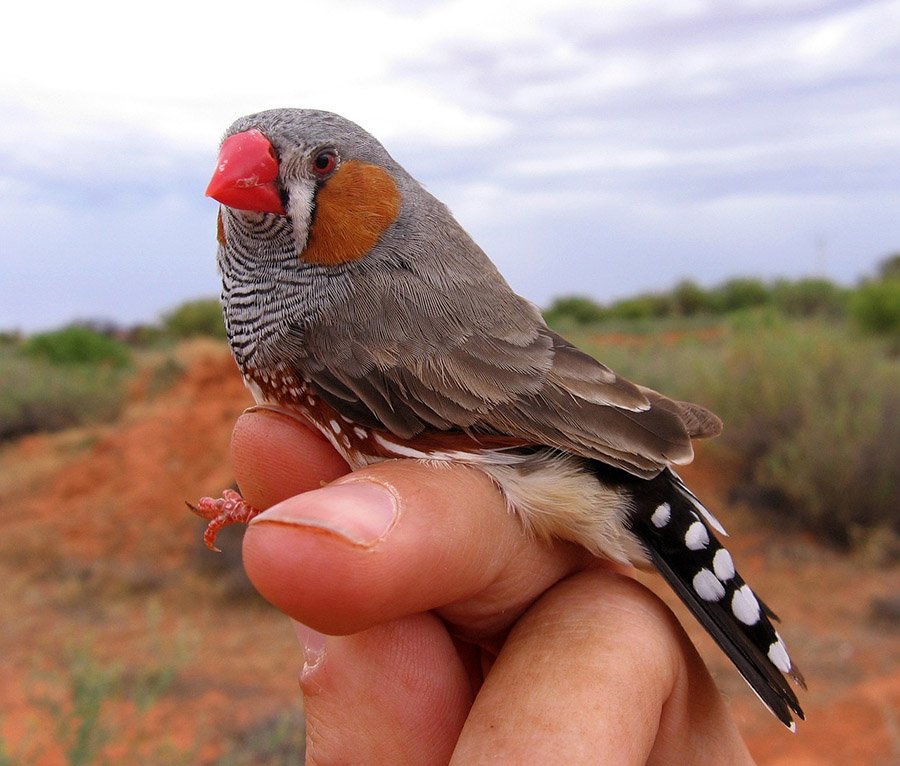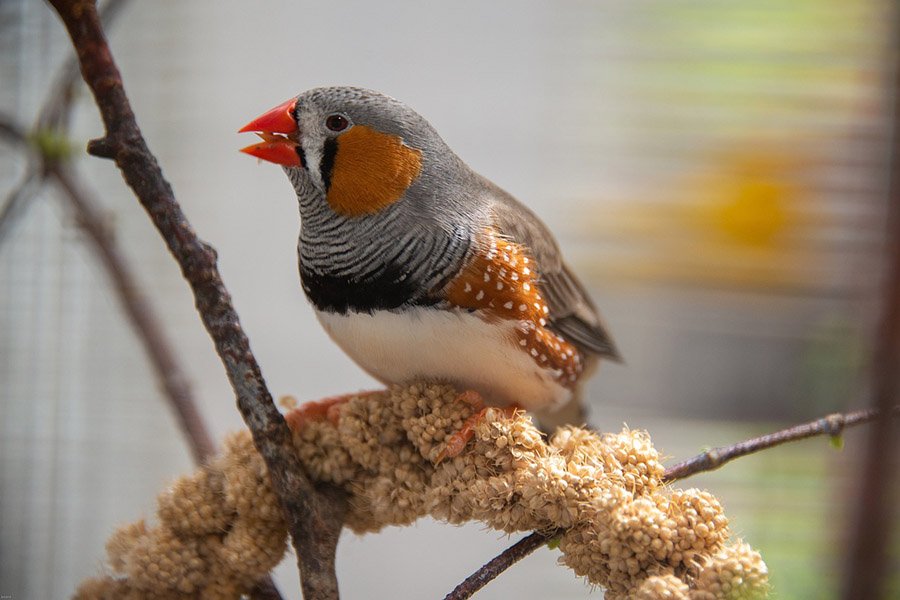Zebra finches, renowned for their vibrant markings and lively personalities, have emerged as a beloved pet bird species across the globe. These small, chirpy birds, named for their distinct “zebra-like” stripes, are not only a joy to watch but also relatively easy to care for, making them an ideal choice for both novice and experienced bird enthusiasts.
Understanding the lifespan of zebra finches is crucial for anyone considering adding these charming birds to their family. It’s not just about the commitment in terms of years; knowing their average lifespan is key to providing the right care and environment that can ensure a healthy and fulfilling life for these birds.
For current owners, this knowledge is equally important as it guides them in adjusting care as their finches age, potentially extending their lives and enhancing their quality of life.
Overview of Zebra Finches
Zebra finches, scientifically known as Taeniopygia guttata, are small, primarily grey birds notable for their characteristic black and white striping on the throat and breast, resembling a zebra’s pattern.
Males typically boast more vibrant colors with cheek patches of bright orange and chestnut flanks with white dots, while females tend to have a more subdued appearance. They typically measure around 10 centimeters in length, making them a compact companion.
In their natural habitat, zebra finches are found in the arid and semi-arid regions of Central Australia. They are highly adaptable, living in a variety of environments but generally prefer areas with grasslands and scattered trees. These birds are known for their robust and melodious song, a delightful symphony that is more pronounced and complex in males.
Their social nature and playful demeanor have contributed to their popularity as pets. Zebra finches are gregarious birds, often seen in pairs or small flocks, and they thrive in social environments, making them excellent companions for those who appreciate active and engaging pets.
Their ease of care, coupled with their charming characteristics, has made them a staple in the avian pet community, appealing to bird lovers of all ages and experience levels.

Average Lifespan of Zebra Finches
In Captivity vs. The Wild
Zebra finches typically live longer in captivity due to controlled environments, consistent food supply, and protection from predators. On average, zebra finches in captivity can live between 5 to 10 years, with some even reaching up to 12 years under optimal care.
In contrast, their lifespan in the wild is shorter, often ranging from 2 to 3 years, primarily due to predators, diseases, and environmental challenges.
Comparison with Other Finch Species
When compared to other finch species, zebra finches have a relatively moderate lifespan. Some finch species may live shorter or slightly longer lives, but this can vary greatly depending on the species and their specific environmental conditions.
The lifespan of zebra finches, especially in captivity, is a testament to their adaptability and the efficacy of proper care and environment provided by their caregivers.

Factors Influencing Zebra Finch Lifespan
The lifespan of zebra finches varies significantly depending on whether they are living in the wild or in captivity. Each setting presents unique challenges and advantages that impact their longevity.
Factors in the Wild
- Natural Predators and Environmental Hazards: In their natural habitat, zebra finches face threats from predators and environmental hazards, such as harsh weather conditions, which can significantly shorten their lifespan.
- Food Scarcity: Availability of food is variable in the wild, and periods of scarcity can lead to malnutrition, affecting their health and longevity.
- Disease Exposure: Wild zebra finches are more exposed to diseases and parasites, which can be fatal without access to veterinary care.
- Stress from Competition: Competition for resources like food, mates, and nesting sites in the wild can lead to stress, impacting their overall health.
Factors in Captivity
- Genetics and Hereditary Factors: Genetic makeup plays a crucial role in the health and lifespan of captive zebra finches. Breeding practices can influence these genetic factors, potentially leading to longer lifespans.
- Diet and Nutrition: A balanced diet is essential for longevity in captivity. Pet zebra finches often have a more consistent and nutritionally complete diet than their wild counterparts.
- Environmental Conditions: Factors like cage size, cleanliness, and a stable climate are critical. Properly maintained living conditions free from stressors can greatly enhance their lifespan.
- Healthcare: Access to veterinary care for regular check-ups and treatments contributes to a longer life in captivity.
- Social Interaction and Mental Stimulation: In captivity, zebra finches require social interaction, either with humans or other birds, and mental stimulation to maintain their mental health, which can indirectly affect their lifespan.
By understanding the distinct factors affecting zebra finches in both wild and captive environments, owners and enthusiasts can better cater to the needs of these birds, optimizing their care for a longer, healthier life.

Maximizing Zebra Finch Lifespan in Captivity
Best Practices in Diet and Nutrition
- Varied Diet: Offer a balanced diet consisting of high-quality finch seed mix, fresh fruits, and vegetables. Avoid over-reliance on seeds as they can lead to obesity.
- Supplements: Incorporate supplements like cuttlebone for calcium, and consider vitamin drops if recommended by a vet.
Creating an Optimal Living Environment
- Spacious Cage: Ensure the cage is spacious enough for flight and exercise.
- Cleanliness: Regularly clean the cage and change water to prevent disease.
- Stable Climate: Keep the cage in a well-ventilated area, away from direct sunlight or drafts, maintaining a stable temperature.
Importance of Regular Veterinary Care
- Routine Check-ups: Regular visits to an avian vet for check-ups can catch health issues early.
- Vaccinations and Treatments: Stay up to date with any recommended vaccinations and treatments.
Mental and Physical Stimulation
- Toys and Activities: Provide toys and perches for physical activity.
- Social Interaction: Allow social interaction with other finches or humans to prevent loneliness and stress.
Maximizing Zebra Finch Lifespan
To maximize the lifespan of zebra finches, several best practices in their care and environment are essential. A balanced diet is crucial; this should include a high-quality finch seed mix, supplemented with fresh fruits and vegetables.
Supplements, like cuttlebone for calcium, are also beneficial. The living environment plays a significant role in their longevity. A spacious, clean cage located in a well-ventilated area with stable temperatures helps prevent stress and disease.
Regular veterinary care is important for early detection and treatment of potential health issues. Moreover, mental and physical stimulation cannot be overlooked.
Providing toys, perches, and opportunities for social interaction with other finches or humans will not only keep them physically active but also mentally engaged, which is vital for their overall well-being.

Common Health Issues in Zebra Finches
In both wild and captive settings, zebra finches can encounter several health issues, though the prevalence and impact of these issues can differ based on their environment.
In the Wild
- Parasitic Infections: Wild finches often face challenges from parasites like mites, which can affect their health and lifespan.
- Predation and Injuries: Injuries from predators or environmental factors can lead to infections and decreased life expectancy.
- Food Scarcity and Malnutrition: Limited food resources can lead to malnutrition, weakening their immune system.
In Captivity
- Respiratory Infections: Common in captive birds, these can be caused by poor air quality or stress.
- Obesity: A diet too high in seeds can lead to obesity, shortening their lifespan.
- Egg Binding: More common in captive female finches, this condition can be life-threatening.
Both wild and captive zebra finches benefit from proactive measures to prevent these issues. In captivity, this includes a balanced diet, clean and safe living conditions, and regular health check-ups.
In the wild, while it’s harder to control these factors, understanding these risks can inform conservation and habitat protection efforts. Early detection and treatment of ailments are key in captivity, while efforts to preserve natural habitats and food sources are crucial in the wild.
Frequently Asked Questions
How long do zebra finches typically live?
Zebra finches usually live between 5 to 10 years in captivity, with optimal care extending their lifespan.
Can zebra finches be kept alone?
While they can survive alone, they thrive in pairs or small groups due to their social nature.
What should I feed my zebra finch?
A mix of quality finch seed, fresh fruits, vegetables, and occasional protein sources like boiled eggs.
How often should I clean my zebra finch’s cage?
It’s best to clean the cage thoroughly at least once or twice a week, with daily removal of waste and food debris.
Do zebra finches need a mate to be happy?
They don’t necessarily need a mate but do require social interaction, either with other birds or humans.





